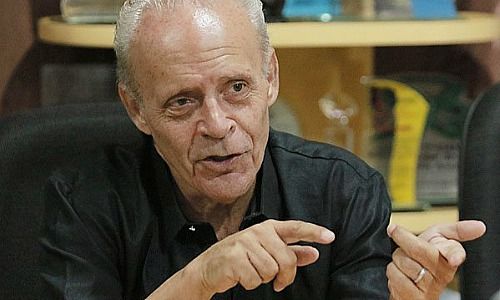The once high-flying Hong Kong, Taiwan, Singapore and South Korea face similar challenges – an ageing population, slowing economy and growing inequality – they must now undertake structural reforms.
finews.first is a forum for renowned authors specialized on economic and financial topics. The texts are published in both German and English. The publishers of finews.com are responsible for the selection.
In his book «The Four Little Dragons», U.S. academic Ezra F. Vogel argued that Taiwan, South Korea, Hong Kong and Singapore were four newly industrialised economies that had followed Japan’s export-led growth model to prosperity. Unlike major advanced economies, which established their position in a century or two, the four dragons made their mark in just a few decades.
Today, the dragons’ world looks very different. There is a common denominator behind Hong Kong’s economic and political malaise, Taiwan President Tsai Ing-wen’s efforts to lean on the Trump White House, South Korea’s mass demonstrations to impeach President Park Geun-hye, and Singapore’s attempt to accelerate economic growth.
Political friction usually follows population ageing and a slowing economy. That’s the common denominator.
«In the process, they leapt «from the third world to the first» within one generation»
Some half a century ago, the four dragons underwent an extraordinary phase of rapid industrialisation, starting with Hong Kong’s textile industry in the 1960s, followed by export-oriented industrialisation in Lee Kuan Yew’s Singapore, modernisation and export expansion in the Kuomintang’s Taiwan, and Park Chung-hee’s South Korea. From the early 1960s to the 1990s, the dragons enjoyed high growth rates. In the process, they leapt «from the third world to the first» within one generation, as Lee later put it.
In 1960, Hong Kong, the first dragon to begin the catch-up, led the group in average living standards; it lagged far behind both the US and Japan, and was followed by Singapore, Taiwan and South Korea. The weakest dragon was South Korea, where living standards were barely 10 per cent of those in America.
As the toughest phase of industrialisation came to an end, by 1980, the dragons were still led by Hong Kong. Although trade friction between the U.S. and Japan was about to dominate headlines, living standards in Hong Kong were now only 25 percent behind those in Japan, but still 45 percent behind those in the U.S.
«Such easy catch-up growth is in the past»
Usually, most economies’ internal engines decelerate after industrialisation, which is associated with high growth. However, the four dragons were in the right place at the right time and made the right growth choices. As China – the ultimate dragon – began its economic reforms and opening-up policies, the little dragons went into overdrive that supported their growth for another three decades.
Today, living standards in all dragons, except for South Korea, are relatively higher than in Japan, which has been overwhelmed by economic stagnation. Intriguingly, living standards in Singapore are now about 35 percent higher than those in America, which Hong Kong has caught up with as well.
But such easy catch-up growth is in the past. In 2017, Singapore hopes for growth of 2 to 3 percent, although analysts expect it to stay below 2 percent. Despite a strong last quarter in 2016, it is coping with economic malaise. Trade outlook is uncertain, due to new protectionism and regional tensions.
«Its future is overshadowed by political angst»
Like Hong Kong, Singapore must also cope with the U.S. Federal Reserve’s rate hikes amid a tight labour market and softening property sector. It is seeking new growth not just in China and emerging Asia but also via economic integration with Malaysia and Riau.
Despite improved prospects, Hong Kong’s growth is about 2 percent. Its future is overshadowed by political angst. Even more than Singapore, it is exposed to global liquidity swings, US trade protectionism and China’s rebalancing in the region.
But unlike Singapore, Hong Kong has missed and continues to shun pro-growth integration opportunities. Failures in leadership are illustrated by the misconduct of former chief executive Donald Tsang Yam-kuen and the weakness of his successor, Leung Chun-ying.
South Korea’s growth rate has been cut to 2.6 percent, and the economic momentum has moderated. Neither foreign trade nor domestic demand, which suffers from indebted households, has been adequate to support strong growth. While rising inflation may generate a rate hike by the Bank of Korea, Seoul must cope with Chinese deceleration and U.S. protectionism. Washington could also target it for alleged currency manipulation.
«Average living standards tend to mask broadening income polarisation»
Despite improved forecasts, Taiwanese growth rate for 2017 is estimated at 1.7 percent. Like Hong Kong, it is struggling with economic and political malaise; the former has to do with maturation, the latter is largely self-induced. Thanks to growing political uncertainty, an investment contraction could follow in due course, especially if friction with China weighs on trade and investment.
Today, the dragons are ageing and slowing, as evidenced by a steady and occasionally steep deceleration of growth in each one. All four dragons are ageing. With the demographic transition, birth and death rates are slowing, as evidenced by a rise in the median age. Among major advanced economies, it is highest in Japan and Germany (47), both of which are facing population decline. Among the dragons, the median age is highest in Hong Kong (44), followed by South Korea (41), Taiwan (40) and Singapore (40).
Worse, average living standards tend to mask broadening income polarisation in the four dragons. Among major advanced economies, income inequality, as measured by the Gini coefficient, is the highest in the U.S. (45), but significantly lower in Japan (32), France and Germany (less than 30). Among the dragons, it is highest in the financial hubs of Hong Kong (54) and Singapore (46), as opposed to hi-tech giants Taiwan (34) and South Korea (30).
«All four dragons need structural reforms and inclusive pro-growth policies»
In the long-run, high living standards require solid growth and strong productivity, which usually rely on sustained innovation. Most dragons are driven by technology innovation, as reflected by their research and development spending as a percentage of gross domestic product. South Korea’s 4.3 percent is one of highest rates in the world, followed by Taiwan (3 percent) and Singapore (2.5 percent). Hong Kong is the laggard at 0.7 percent.
All four dragons need structural reforms and inclusive pro-growth policies, to raise productivity, as well as innovation and R&D investments. They also need to encourage more dynamic competition and new enterprises; raise retirement ages, accelerate skill-based immigration, get more women to join the workforce; and achieve greater efficiency of public spending.
A greater stress on human capital also requires more progressive taxation, aggressive measures to reduce income inequality and adequate job protection legislation.
Finally, as the dragons’ internal growth engines are slowing, they must aggressively seek greater economic integration regionally, and international trading arrangements. In the absence of such changes, all four dragons could face creeping stagnation.
Dan Steinbock is the founder of the Difference Group and has served as the research director at the India, China, and America Institute (U.S.) and as a visiting fellow at the Shanghai Institutes for International Studies (China) and the EU Centre (Singapore). This article also appeared in the «South China Morning Post».
Previous contributions: Rudi Bogni, Peter Kurer, Oliver Berger, Rolf Banz, Dieter Ruloff, Samuel Gerber, Werner Vogt, Walter Wittmann, Alfred Mettler, Peter Hody, Robert Holzach, Craig Murray, David Zollinger, Arthur Bolliger, Beat Kappeler, Chris Rowe, Stefan Gerlach, Marc Lussy, Nuno Fernandes, Beat Wittmann, Richard Egger, Maurice Pedergnana, Didier Saint-George, Marco Bargel, Steve Hanke, Andreas Britt, Urs Schoettli, Ursula Finsterwald, Stefan Kreuzkamp, Katharina Bart, Oliver Bussmann, Michael Benz, Peter Hody, Albert Steck, Andreas Britt, Martin Dahinden, Thomas Fedier, Alfred Mettler, Frédéric Papp, Brigitte Strebel, Peter Hody, Mirjam Staub-Bisang, Guido Schilling, Claude Baumann, Adriano B. Lucatelli, Nicolas Roth, Thorsten Polleit and Kim Iskyan.


























